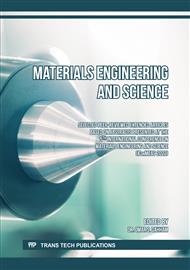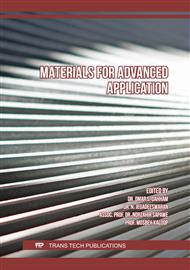[1]
A. P. Irawan, W. Sukania, P. T. Anggarina, A. R Danendra and G. D. Baskara, Socket prosthesis manufacturing process made from bamboo fiber composite materials, IOP Conf. Series: Materials Science and Engineering 852 (2020) 0120-42.
DOI: 10.1088/1757-899x/852/1/012042
Google Scholar
[2]
S. A. Mechi and M. Al-Waily, Fatigue Characterizations Modifying for Below Knee Prosthesis Composite Materials by using Natural Knitted Kenaf Reinforcement Fibers, International Energy & Environment Foundation journal, 12 (2021).
DOI: 10.1088/1742-6596/1973/1/012168
Google Scholar
[3]
N. Lakshmi and P. Ronanki, Experimental Study on Mechanical and Tribological Properties of Biodegradable Natural Fiber Composites, International Journal of Mechanical and Production Engineering Research and Development, 10 (2020).
Google Scholar
[4]
S. Jiang, Y. Wei, Z. Hu, S. Ge, H. Yang and W. Peng, Potential application of bamboo powder in PBS bamboo plastic composites, by ScienceDirect, Published by Elsevier, Journal of King Saud University – Science 32 (2020) 1130–1134.
DOI: 10.1016/j.jksus.2019.10.014
Google Scholar
[5]
H. A. Sallal, Effect of the Addition Coconut Shell Powder on Properties of Polyurethane Matrix Composite, Al-Nahrain University, College of Engineering Journal (NUCEJ) 17, (2014) 203-210.
Google Scholar
[6]
I. Widiastuti, M. Solikhun, D. N. Cahyo, Y. R. Pratiwi and H. Juwantono, Treatment of Bamboo Fibres in Improving Mechanical Performance of Polymer Composites – A Review, AIP Conference Proceedings 1977 (2018) 030-046.
DOI: 10.1063/1.5042966
Google Scholar
[7]
L. Tombolato, E. E. Novitskay, P. Y. Chen, F. A. Sheppard and J. McKittrick, Microstructure, elastic properties and deformation mechanisms of horn keratin, by ScienceDirect, Published by Elsevier, Acta Biomaterialia journal 6 (2010) 319–330.
DOI: 10.1016/j.actbio.2009.06.033
Google Scholar
[8]
W. N. Nkeuwa, J. Zhang, K. E. Semple, M. Chen, Y. Xia and C. Dai, Bamboo-based composites: A review on fundamentals and processes of bamboo bonding, by ScienceDirect, Published by Elsevier, Composites Part B 235 (2022) 109776.
DOI: 10.1016/j.compositesb.2022.109776
Google Scholar
[9]
Z. K. Hamdan, Z. w. metteb and F. A. Abdulla, Mechanical properties of recycled natural composite material with polyester, Journal of Mechanical Engineering Research and Developments, 44 (2021).
Google Scholar
[10]
S. Parbina, N. K. Waghmareb, S. K. Singhb and S. Khanc, Mechanical properties of natural fiber reinforced epoxy composites: A review, by ScienceDirect, Published by Elsevier, Procedia Computer Science 152 (2019) 375–379.
DOI: 10.1016/j.procs.2019.05.003
Google Scholar
[11]
W. A. Hanna, A. K. Hussei and H. A. Sallal, Ceramic Filled Polymer Matrix Composite Used for Bio-Medical Application, Eng. & Tech. Journal, 29 (2011).
Google Scholar
[12]
A. K. Sinha, K. Harendra, N. and S. Bhattacharya, Mechanical properties of natural fibre polymer composites: Review, Journal Polymer Eng 37 (2017) 879–895.
DOI: 10.1515/polyeng-2016-0362
Google Scholar
[13]
H. Naznin, A. K. Mallik, K. S. Hossain, M. D. Shahruzzaman, P. Haque and M. Mizanur Rahman, Enhancement of thermal and mechanical properties of PMMA composites by incorporating mesoporous micro-silica and GO, by ScienceDirect, Published by Elsevier, Results in Materials 11 (2021) 100203.
DOI: 10.1016/j.rinma.2021.100203
Google Scholar
[14]
N Hellen, H. Park, and K. N. Kim, Characterization of ZnO/TiO2 Nanocomposites Prepared via the Sol-Gel Method, Journal of the Korean Ceramic Society 55 (2018) 140-144.
DOI: 10.4191/kcers.2018.55.2.10
Google Scholar
[15]
S. Balos, T. Puskar, M. Potran, B. Milekic, D. D. Koprivica, J. L. Terzija and I. Gusic, Modulus, Strength and Cytotoxicity of PMMA-Silica Nanocomposites, by MDPI, Coatings journal ,2020, 10, 583.
DOI: 10.3390/coatings10060583
Google Scholar
[16]
Saif mohammed abbas, Effects of Composite Material Layers on the Mechanical Properties for Partial Foot Prosthetic Socket, Al-Nahrain Journal for Engineering Sciences, 21 (2018) 253-258.
DOI: 10.29194/njes21020253
Google Scholar
[17]
D. Kumar, S. R. Boopathy, D. Sangeetha and G. Bharathiraja, Investigation of Mechanical Properties of Horn Powder-Filled Epoxy Composites, Journal of Mechanical Engineering, 63 (2017).
DOI: 10.5545/sv-jme.2016.3764
Google Scholar
[18]
A. I. Shuaibyl, T. Alasi, I. N. Aremu, H. K. Ibrahim, Z. U. Elakhame and S. O. Abdulraman, Suitability of Cow Horn as Filler in an Epoxy Composite, J. Appl. Sci. Environ. Manage.Vol. 23 (2019) 475-482.
DOI: 10.4314/jasem.v23i3.17
Google Scholar
[19]
A. U. Shah, T. H. M. Sultan and M. Jawaid, Sandwich-structured bamboo powder/glass fiber-reinforced epoxy hybrid composites – Mechanical performance in static and dynamic evaluations, Journal of Sandwich Structures & Materials, 18 (2019).
DOI: 10.1177/1099636218822740
Google Scholar
[20]
D. J. Hassan and N. A. Ali, Evaluation of Mechanical Properties for Epoxy reinforced with palm oil /Zinc oxide composites, Iraqi Journal of Physics, 20 (2022) 26-37.
DOI: 10.30723/ijp.v20i2.978
Google Scholar
[21]
M. M. Ali, M. J. Haque, M. H. Kabir, M. A. Kaiyum, M.S. Rahman, Nano synthesis of ZnO–TiO2 composites by sol-gel method and evaluation of their antibacterial, optical and photocatalytic activities, by ScienceDirect, Published by Elsevier, Results in Materials 11 (2021) 100199.
DOI: 10.1016/j.rinma.2021.100199
Google Scholar
[22]
R. Hasanzadeh, S. Rashahmadi and H. Memari, Experimental investigation of mechanical properties of pmma nanocomposites containing various contents of prevalent nanofillers from multi-criteria decision analysis point of view, Journal of Mechanics, 34 (2018).
DOI: 10.1017/jmech.2017.26
Google Scholar
[23]
J. Sim, Y. Kang, B. J. Kim, Y. H. Park and Y. C. Lee, Preparation of Fly Ash/Epoxy Composites and Its Effects on Mechanical Properties, by MDPI, Polymers 12 (2020) 79.
DOI: 10.3390/polym12010079
Google Scholar
[24]
H. A. Sallal, The Effect of the Hybrid Additions on the Bending and Tensile Behavior for the Hybrid Composite Material Reinforced by Short Fibers and the Zeolite Particles by Multifarious Grain, Al-Nahrain Journal for Engineering Sciences (NJES) 20 (2017) 113 – 119.
Google Scholar
[25]
H. A. Sallal, A. A. Abdul-Hamead and F. M. Othman, Effect of nano powder (Al2O3-CaO) addition on the mechanical properties of the polymer blend matrix composite, by ScienceDirect, Published by Elsevier, Defence Technology 16 (2020) 425-431.
DOI: 10.1016/j.dt.2019.07.013
Google Scholar
[26]
M. H. Mahboba, H. A. Sallala and F. H. Ali, Effect of Particles Size of Zirconia on the Mechanical Behavior of the Polymer Blend, AIP Conference Proceedings 22 (2020) 020310.
DOI: 10.1063/5.0002888
Google Scholar



